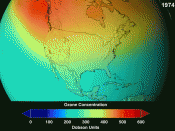The ozone layer diminishes more each year. As the area of polar ozone depletion (commonly called the ozone hole) gets larger, additional ultraviolet rays are allowed to pass through. These rays cause cancer, cataracts, and lowered immunity to diseases.1 What causes the depletion of the ozone layer? In 1970, Crutzen first showed that nitrogen oxides produced by decaying nitrous oxide from soil-borne microbes react catalytically with ozone hastening its depletion. His findings started research on "global biogeochemical cycles" as well as the effects of supersonic transport aircraft that release nitrogen oxide into the stratosphere.2 In 1974, Molina and Rowland found that human-made chlorofluorocarbons used for making foam, cleaning fluids, refrigerants, and repellents transform into ozone-depleting agents.3 Chlorofluorocarbons stay in the atmosphere for several decades due to their long tropospheric lifetimes. These compounds are carried into the stratosphere where they undergo hundreds of catalytic cycles with ozone.4 They are broken down into chlorine atoms by ultraviolet radiation.5
Chlorine acts as the catalyst for breaking down atomic oxygen and molecular ozone into two molecules of molecular oxygen. The basic set of reactions that involve this process are: Cl + O3 -->ClO + O2 and ClO + O -->Cl + O2 The net result: O3 + O -->2O2 Chlorine is initially removed in the first equation by the reaction with ozone to form chlorine monoxide. Then it is regenerated through the reaction with monatomic oxygen in the second equation. The net result of the two reactions is the depletion of ozone and atomic oxygen.6 Chlorofluorocarbons (CFCs), halons, and methyl bromide are a few of the ozone depletion substances (ODS) that break down ozone under intense ultraviolet light. The bromine and fluorine in these chemicals act as catalysts, reforming ozone (O3) molecules and monatomic oxygen into molecular oxygen (O2). In volcanic eruptions, the sulfate...



Yea! GOOD WORK
nicely done
1 out of 1 people found this comment useful.